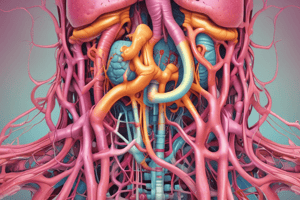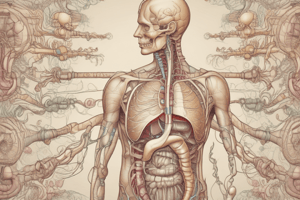Podcast
Questions and Answers
Which part of the autonomic nervous system generally promotes rest and relaxation in the body?
Which part of the autonomic nervous system generally promotes rest and relaxation in the body?
What is the main responsibility of parasympathetic fibers in the context of the stomach?
What is the main responsibility of parasympathetic fibers in the context of the stomach?
Which function does the sympathetic nervous system primarily serve in the stomach?
Which function does the sympathetic nervous system primarily serve in the stomach?
What is the purpose of proper venous drainage in the stomach?
What is the purpose of proper venous drainage in the stomach?
Signup and view all the answers
Which system is responsible for controlling unconscious functions like maintaining heart rate and breathing?
Which system is responsible for controlling unconscious functions like maintaining heart rate and breathing?
Signup and view all the answers
Study Notes
Stomach and Autonomic Nervous System
The stomach plays a crucial role in the digestive system, breaking down food into smaller components before delivering it to the intestines. Its functionality is significantly influenced by the autonomic nervous system, which maintains and regulates various aspects of gastric health.
Autonomic Nervous System
The autonomic nervous system (ANS) is responsible for controlling unconscious functions in the body, including maintaining heart rate and breathing. It is divided into two parts: the sympathetic nervous system (SNS) and the parasympathetic nervous system (PNS). Both systems work together to ensure proper functioning of the body.
Parasympathetic Fibers
Parasympathetic fibers originate from the parasympathetic nervous system, which generally promotes rest and relaxation in the body. Within the context of the stomach, parasympathetic fibers play an essential role in stimulating gastric activity, primarily responsible for muscular contractions needed for digestion.
Sympathetic Fibers
Sympathetic fibers, on the other hand, contribute to the 'fight or flight' response, preparing the body to respond to threats or emergencies. Their role in the stomach includes promoting relaxation and allowing for the passage of food through the digestive system.
Venous Drainage of the Stomach
Proper venous drainage is necessary to remove blood from the organ and facilitate nutrient transport throughout the body. The stomach receives venous blood from the mesenteric vein and the splenic vein.
Arterial Supply of the Stomach
The stomach is supplied with oxygenated arterial blood by the celiac trunk, which branches into two main areas: the left gastric artery and the right gastric artery. The left gastric artery provides blood to the greater curvature of the stomach, while the right gastric artery supplies the lesser curvature and the antrum.
Studying That Suits You
Use AI to generate personalized quizzes and flashcards to suit your learning preferences.
Description
Explore the crucial role of the stomach in digestion and its interaction with the autonomic nervous system. Learn about the functions of parasympathetic and sympathetic fibers in regulating gastric activity, as well as the venous drainage and arterial supply of the stomach.



